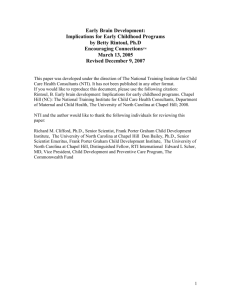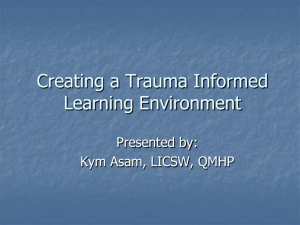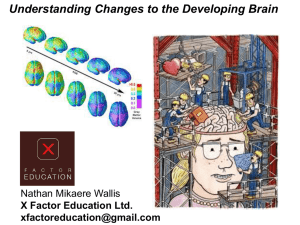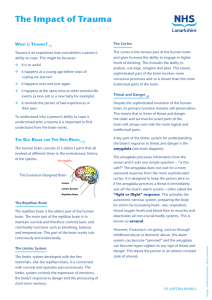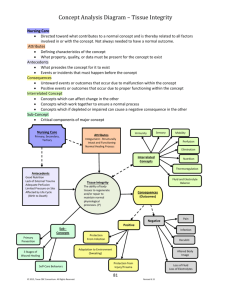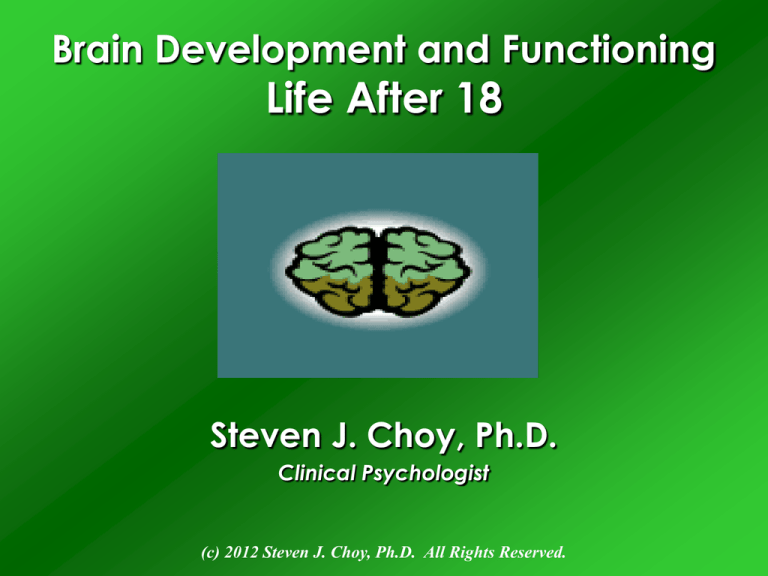
Brain Development and Functioning
Life After 18
Steven J. Choy, Ph.D.
Clinical Psychologist
(c) 2012 Steven J. Choy, Ph.D. All Rights Reserved.
Early Understanding of Brain Development
Limited
by Technology – Structure, Functioning
and Amount of Resources Used-Brain Activity
Believed
that most connections and structure
of the brain was to be developed by age 5
years of age
Structure and composition of the brain was
thought to be fully developed by age 16 years
There was little you could do to improve
damaged/injured neurons and there was
minimal increases in neurons after 16 years old
Brain is Hardwired and Fixed
Brain Functioning & Development
The Brain is Capable of:
Repairing Injured Neurons
Producing New Neurons
Establishing New Synapses
Current Research (within the Last Decade)
Although
most rapid brain development
occurs from 0-5 years and by 6 years the
brain is about 90% of the adult size, new
research have found that substantial
structural, functional, and chemical
changes occur during adolescence
More importantly research have found that
there continues to be substantial
maturational development of the brain well
into early to mid-twenties in woman and
even up to 30 years in men
New Period of Development Between
Adolescents and Adulthood
Emerging Adult
Substantial changes found in youth as they entered
Freshman year of college – Living away from home
Changes noted in the cingulate cortex, caudate
nucleus, and the insula cortex (Bennett & Baird 2006)
Executive Functioning – Judgment & Decision Making
Learning and Memory
Emotional Formation and Feedback
Behavioral Regulation
Bennett, C and Baird, A. Anatomical Change in the Emerging Adult Brain:
A Voxel-Based Morphometry Study. Human Brain Mapping, 27:777-777 (2006).
Bennett, C and Baird, A. Anatomical Change in the Emerging Adult Brain:
A Voxel-Based Morphometry Study. Human Brain Mapping, 27:777-777 (2006).
During the Emerging Adult Period the
brain has not yet developed the full
capacity for judgment, decision making,
and emotional and behavioral regulation
Dopamine levels that change during
adolescence continue into the mid 20s.
Dopamine affects the association
between action and pleasure and can
result in increase in risky behaviors in
youth
Statistics indicate that increase in various
risky behaviors starts in adolescence but
continue well into the mid-twenties
One
of the highest number of DUI offenses
occur between the ages of 16-25 years
(National Drunk Driving Accident Statistics,
2010)
Increase in Risky Sexual behaviors (STD
associated risk behaviors) between the ages
of 18-20 (Sales, J., et. al. 2012)
The brain demonstrates neuroplasticity – the
ability of the brain to alter its structure in
response to experiences after age 18 years
Pruning
can still occur (eliminating
underused synapses) Reducing the effects of
negative associations
New Synapses can form after age 18 years –
positive associations
Trauma, especially complex trauma,
disrupts and slows brain development
Trauma also affects brain functioning and
the synapses and pruning process
BRAIN FUNCTIONING
Amount of
Brain Activity
Area of
Functioning
Cortical
Abstract Thoughts
Judgment
Learning
Limbic
Attachment
Emotional Reactivity
Sexual Behaviors
Midbrain
Arousal/Vigilance
Appetite/Satiety
Sleep
Brainstem
Heart Rate
Blood Pressure
Body Temperature
Marcellus, John, Neurodevelopmental Sequelae of Child Maltreatment, 1997
13
Trauma and Brain Activity
Normal
Traumatized
Cortical
Cortical
Limbic
Limbic
Midbrain
Midbrain
Brainstem
Brainstem
Kent, Sullivan and Rauch. “The Neurobiology of Fear”. Psychiatric Annals. Volume 310, No 12, 2000. 14
Can We Help Children Recover From Abusive Trauma ?
Normal
Brain
Traumatized
Brain
Re-Wired
Brain
Marcellus, John, Neurodevelopmental Sequelae of Child Maltreatment, 1997
15
16
THE BRAIN……
IS AN ASSOCIATIVE ORGAN
(RELATED REPRESENTATIONS)
17
Trauma and Associative Memory
Continued Exposure to Traumatic
Experience involving Significant
Others Reinforces Associative
Memory to Negative Experience
to People in General
Perry, Bruce. Violence and Trauma: Understanding and Responding
to the Effects of Violence on Young Children. 1996.
18
Trauma and Associative Memory
The Brain can be Re-Wired to Develop
more Positive Associations
“The exciting lesson from a range of
sciences is that while experience shapes
who we are, we are NOT destined to
repeat the traumas of our past IF we
make sense of their impact on our lives.”
-Siegel
20
Mirror Neurons
Found in Left and Right
Hemispheres
Involves a temporo-parietofrontal circuit
Bridges Perceptual part of
brain with Motor part of the
brain
It becomes activated with
connections to others
It is related to Trust,
Attachment and Empathy
Secured Relationships
A SECURE ATTACHMENT PROMOTES
GROWTH OF NEURAL INTEGRATIVE FIBERS
(ESPECIALLY ORBITOFRONTAL CORTEX)
21
22
ORBITOFRONTAL CORTEX
Senior Executive of the Emotional Brain
Regulates Interpersonal and Social
Behavior
Directly Connects to All Areas of the
Brain
Brainstem
Limbic System
Cerebral Cortex: Right Hemisphere Specializes in
Inhibitory Control
Perry, Bruce.”Neurodevelopmental Factors In The ‘Cycle Of Violence.” In Child, Youth and
Violence: The Search For Solutions. J Osofsky, Ed. Guilford Press, New York, pp124-148, 1997.
23
Brain Development & Foster Care to 21
Judgment, Decision-making, and Emotional and Behavioral
Regulation is still developing after 18 years.
Youth need to participate in the decision making process regarding all
aspects of their life with supportive assistance
Because there will still be mistakes and there needs to be an extended
safety net to help youth recover from these experiences
Need to work through the developmental need for independence and
the need for a safe and supportive environment
The effects of trauma may impact the development of trust,
attachment, and empathy
Need a longer time to work through family issues, especially if there
was minimal contact with family – supportive environment to work out
issues
Need a longer time to establish social capital
Need extra time to develop and maintain long term secure
relationships


